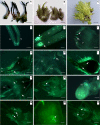Comparison of ultrastructure, pollen tube growth pattern and starch content in developing and abortive ovaries during the progamic phase in hazel
- PMID: 25339969
- PMCID: PMC4186277
- DOI: 10.3389/fpls.2014.00528
Comparison of ultrastructure, pollen tube growth pattern and starch content in developing and abortive ovaries during the progamic phase in hazel
Abstract
HIGHLIGHTSIn an abortive ovary of hazel, an integument seldom differentiated and a mature embryo sac never developed.In an abortive ovary of hazel, pollen tube growth was arrested at the style base about 40 days after blooming. Thus, fertilization of the ovule was precluded.Ovary abortion in the four hybrid cultivars was indicated to be associated with insufficient resource availability to support fruit set by all flowers, whereas ovary abortion in C. heterophylla was at least partly determined by pollen availability. In Northeast China, a high frequency of ovary abortion contributes to serious losses in yield of hazelnut. The development of pistillate inflorescences and fruit clusters of four large-fruited hybrid hazel cultivars and the small-fruited Corylus heterophylla were used to study ovary abortion and its possible causes during the progamic phase in hazel. The average number of pistillate (ANP) flowers per inflorescence and average number of fruit (ANF) per cluster of four hybrid hazel cultivars were 7.6-8.5 and 2.4-3.0 respectively; in C. heterophylla, its ANP and ANF was 5.8-6.2 and 3.5, respectively. The total drop varied from 50 to 67%. Ovary abortion in hazel initiated from about 30 days after blooming. The percentage of abortive ovaries (PAO) in the four hybrid hazel cultivars ranged from 63 to 72%, and was significantly higher than that of C. heterophylla (29-42%). Only the abortive ovary ratio of C. heterophylla was significantly reduced after artificial pollination. Fruit number per cluster was positively and negatively correlated with yield and nut mass, respectively. In abortive ovaries, the diameter remained less than 2 mm during the entire fruit development, an integument seldom differentiated and a mature embryo sac never developed. In addition, pollen tube growth was arrested at the style base about 40 days after blooming. Thus, fertilization of the ovule was precluded. Compared with abortive ovary, starch content in developing ovary of four hybrid hazel cultivars and C. heterophylla were significantly higher. This study suggests that abortive ovary was incapable to finish fertilization process due to the absence of mature embryo sac and arrested pollen tubes, and this is likely associate with insufficient resource availability to support fruit set by all flowers in four hybrid hazel cultivars, whereas ovary abortion in C. heterophylla is at least partly determined by pollen availability.
Keywords: abortive ovary; delayed fertilization; fruit cluster; hazelnut; pistillate inflorescence.
Figures


Similar articles
-
Identification of genes regulating ovary differentiation after pollination in hazel by comparative transcriptome analysis.BMC Plant Biol. 2018 May 9;18(1):84. doi: 10.1186/s12870-018-1296-3. BMC Plant Biol. 2018. PMID: 29739322 Free PMC article.
-
Pistillate flower development and pollen tube growth mode during the delayed fertilization stage in Corylus heterophylla Fisch.Plant Reprod. 2014 Sep;27(3):145-52. doi: 10.1007/s00497-014-0248-9. Epub 2014 Jul 30. Plant Reprod. 2014. PMID: 25073757
-
Transcriptome analysis and gene expression profiling of abortive and developing ovules during fruit development in hazelnut.PLoS One. 2015 Apr 2;10(4):e0122072. doi: 10.1371/journal.pone.0122072. eCollection 2015. PLoS One. 2015. PMID: 25836368 Free PMC article.
-
Floral anatomy, embryology, seed, and fruit development in Cephalanthus (Naucleeae-Rubiaceae), with emphasis on C. glabratus.Protoplasma. 2022 Mar;259(2):237-261. doi: 10.1007/s00709-021-01664-8. Epub 2021 May 15. Protoplasma. 2022. PMID: 33990859 Review.
-
Paving the Way for Fertilization: The Role of the Transmitting Tract.Int J Mol Sci. 2021 Mar 5;22(5):2603. doi: 10.3390/ijms22052603. Int J Mol Sci. 2021. PMID: 33807566 Free PMC article. Review.
Cited by
-
Evaluation of Pathogenicity of the Fungi Metarhizium anisopliae and Beauveria bassiana in Hazelnut Weevil (Curculio nucum L., Coleoptera, Curculionidae) Larvae.Indian J Microbiol. 2016 Dec;56(4):405-410. doi: 10.1007/s12088-016-0614-4. Epub 2016 Aug 13. Indian J Microbiol. 2016. PMID: 27784935 Free PMC article.
-
Identification of vital candidate microRNA/mRNA pairs regulating ovule development using high-throughput sequencing in hazel.BMC Dev Biol. 2020 Jul 1;20(1):13. doi: 10.1186/s12861-020-00219-z. BMC Dev Biol. 2020. PMID: 32605594 Free PMC article.
-
Identification of genes regulating ovary differentiation after pollination in hazel by comparative transcriptome analysis.BMC Plant Biol. 2018 May 9;18(1):84. doi: 10.1186/s12870-018-1296-3. BMC Plant Biol. 2018. PMID: 29739322 Free PMC article.
-
Comparative analysis of the transcriptome during single-seed formation of Castanea henryi: regulation of starch metabolism and endogenous hormones.BMC Plant Biol. 2023 Feb 13;23(1):90. doi: 10.1186/s12870-023-04102-4. BMC Plant Biol. 2023. PMID: 36782110 Free PMC article.
-
The ectomycorrhizal fungus Scleroderma bovista improves growth of hazelnut seedlings and plays a role in auxin signaling and transport.Front Microbiol. 2024 Aug 7;15:1431120. doi: 10.3389/fmicb.2024.1431120. eCollection 2024. Front Microbiol. 2024. PMID: 39171259 Free PMC article.
References
-
- Aydinoglu A. C. (2013). Examining environmental condition on the growth areas of Turkish hazelnut (Corylus colurna L.). Afr. J. Biotechnol. 9, 6492–6502 10.5879/AJB10.400 - DOI
-
- Bertin N., Gautier H., Roche C. (2002). Number of cells in tomato fruit depending on fruit position and source-sink balance during plant development. Plant Growth Regul. 36, 105–112 10.1023/A:1015075821976 - DOI
-
- Beyhan N., Marangoz D. (2007). An investigation of the relationship between reproductive growth and yield loss in hazelnut. Sci. Hortic. 113, 208–215 10.1016/j.scienta.2007.02.007 - DOI
LinkOut - more resources
Full Text Sources
Other Literature Sources

